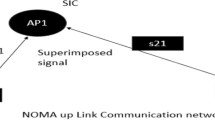Abstract
We develop an algorithm that allows an ARQ protocol to dynamically optimize the packet size based on estimates of the channel bit‐error‐rate. Our algorithm is particularly useful for wireless and satellite channels where the bit‐error‐rates tend to be relatively high and time variable. Our algorithm uses the acknowledgment history to make estimates of the channel bit‐error‐rate, based on which the optimal packet size can be chosen. We develop a Markov chain model for the analysis of the system, under static channel conditions, and show that the algorithm can achieve close to optimal performance using a history of just 10,000 bits. We also use the Gilbert–Elliott two‐state Markov channel to model dynamic channel conditions. We show, through simulation, that the algorithm performs well even under rapidly changing channel conditions. Finally, we discuss a maximum likelihood approach for choosing the packet size, which performs almost optimally but is much easier to implement.
Similar content being viewed by others
References
D.P. Bertsekas and R. Gallager, Data Networks (Prentice-Hall, Englewood Cliffs, NJ, 1987).
P. Bhagwat et al., Enhancing throughput over wireless LANs using channel state dependent packet scheduling, in: Proc. of Infocom '96, San Francisco, CA (April 1996).
E.O. Elliott, Estimates of error rates for codes on burst-noise channels, Bell System Technical Journal (September 1993).
E.N. Gilbert, Capacity of a burst-noise channel, Bell System Technical Journal (September 1960).
E. Modiano, Data link protocols for LDR MILSTAR communications, Lincoln Laboratory, Communications Division Internal Memorandum (October 1994).
M. Moeneclaey and H. Bruneel, Efficient ARQ scheme for high error rate channels, Electronic Letter 20 (1984) 986–987.
A.R.K. Sastry, Improving automatic repeat request (ARQ) performance on satellite channels under high error rate conditions, IEEE Transactions on Communications 23 (1975) 436–439.
M. Schwartz, Telecommunication Networks: Protocols, Modeling and Analysis (Addison-Wesley, Reading, MA, 1987).
Y. Yao, An effective Go-Back-N ARQ scheme for variable-errorrate channels, IEEE Transactions on Communications 43(1) (January 1995).
M. Zorzi, R.R. Rao and L.B. Milstein, On the accuracy of a first order Markov model for data transmission on fading channels, in: Proc. of the 4th International Conference on Universal Personal Communication, Tokyo, Japan (November 1995).
Author information
Authors and Affiliations
Rights and permissions
About this article
Cite this article
Modiano, E. An adaptive algorithm for optimizing the packet size used in wireless ARQ protocols. Wireless Networks 5, 279–286 (1999). https://doi.org/10.1023/A:1019111430288
Issue Date:
DOI: https://doi.org/10.1023/A:1019111430288




